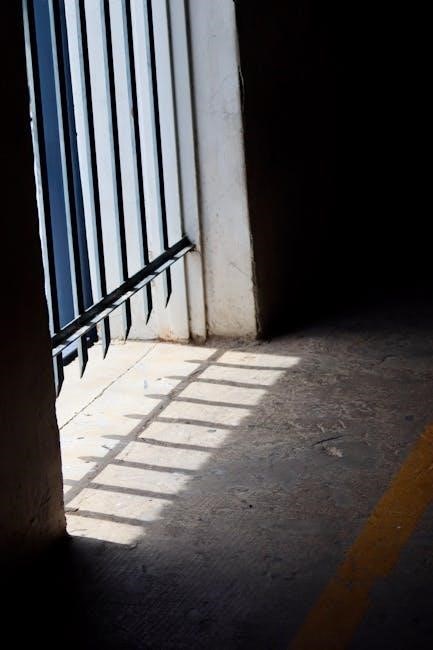Robert Frost’s Mending Wall (1914) explores themes of isolation, tradition, and human connection through the annual ritual of repairing a stone wall between two properties.
In “Mending Wall,” Robert Frost explores themes of isolation and tradition through the annual ritual of repairing a stone wall between two properties. The speaker describes how natural forces, like the frozen-ground-swell, damage the wall, creating gaps that need mending. Each spring, the speaker and his neighbor meet to repair the wall, walking on opposite sides and gathering fallen boulders. The speaker questions the purpose of the wall, while the neighbor insists, “Good fences make good neighbors.” The poem reflects on boundaries, human connection, and the tension between progress and tradition.
Historical Context and Background
Mending Wall was first published in 1914 in Robert Frost’s collection North of Boston. The poem is autobiographical, drawing inspiration from Frost’s experiences with his French-Canadian neighbor, Napoleon Guay, in New Hampshire. The rural setting reflects Frost’s fascination with the isolation and traditions of New England life. The poem’s exploration of boundaries and human connection resonated during a time of societal change, making it a timeless reflection on the walls we build—both literal and metaphorical.

Themes in “Mending Wall”
Themes in Mending Wall include isolation, tradition, and the symbolism of the wall as a metaphor for human boundaries and the complexities of neighborly relationships.
Isolation and Individualism
The poem explores the theme of isolation and individualism through the ritual of mending the wall, which serves as a physical and emotional barrier between the speaker and his neighbor. The speaker questions the necessity of the wall, reflecting a desire for connection, while the neighbor insists on maintaining it, symbolizing stubborn adherence to tradition. This contrast highlights the tension between isolation and the human need for relationship, as well as the individualism that often accompanies rural life. The wall becomes a metaphor for the boundaries people construct to separate themselves from others.
Tradition and Ritual
The poem delves into the theme of tradition and ritual through the annual act of mending the wall, a practice passed down through generations. The speaker and his neighbor meet each spring to repair the wall, a ritual that underscores their respect for boundaries and inherited customs. The neighbor’s adherence to the tradition, even without questioning its purpose, highlights the endurance of societal norms. The speaker’s introspection, however, challenges the necessity of this ritual, suggesting a tension between upholding tradition and embracing change.
The Symbolism of the Wall
The wall in Robert Frost’s Mending Wall serves as a potent symbol for human-made divisions and boundaries. It represents the physical and emotional barriers people construct to separate themselves from others. The wall’s constant need for repair highlights the futility of such divisions, as natural forces and human actions continually disrupt them. The poem suggests that while walls may provide a sense of security or tradition, they also perpetuate isolation and hinder genuine connection. The wall, thus, becomes a metaphor for the tension between separation and unity in human relationships.

Poetic Devices and Style
Robert Frost employs dialogue, imagery, and symbolism to explore themes of isolation and tradition. The poem’s continuous structure and natural imagery enhance its reflective tone and depth.
Imagery and Symbolism
Imagery in Mending Wall vividly portrays the natural world, with the wall symbolizing division and tradition. Frost uses the frozen-ground-swell and spilled boulders to illustrate nature’s resistance to human barriers. The hunters’ destruction of the wall adds another layer, suggesting external forces disrupt human rituals. The annual mending ritual itself becomes a symbol of persistent tradition, while the wall embodies both separation and connection. These elements create a rich tapestry of meaning, inviting readers to ponder the futility and necessity of boundaries in human life.
Irony and Subtlety in Dialogue
The dialogue in Mending Wall is laced with irony and subtlety, particularly in the neighbor’s repetition of “Good fences make good neighbors.” This phrase, often taken at face value, reveals the neighbor’s stubborn adherence to tradition. Meanwhile, the speaker’s internal questioning and skepticism add depth, suggesting a quiet rebellion against unnecessary barriers. The exchange subtly highlights the tension between tradition and progress, as well as the complexity of human relationships, where words often mask deeper emotions and unspoken conflicts.
Structure and Rhythm
Mending Wall is written in blank verse, with an irregular rhythm that mimics natural speech. Frost’s use of unrhymed iambic pentameter creates a conversational tone, while the continuous structure without stanza breaks reflects the ongoing, cyclical nature of the wall-mending task. This rhythmic simplicity complements the poem’s exploration of human connection and labor, emphasizing the repetitive yet meditative act of rebuilding boundaries. The structure subtly mirrors the speaker’s introspection, blending the physicality of the wall with deeper philosophical musings.
Analysis of Key Lines
Key lines like “Good fences make good neighbors” and “Something there is that doesn’t love a wall” explore themes of boundaries, tradition, and human connection, reflecting Frost’s deeper philosophical inquiry into isolation and unity.
The Phrase “Good Fences Make Good Neighbors”
The phrase “Good fences make good neighbors” is central to Mending Wall, highlighting themes of separation and unity. It reflects the neighbor’s belief in boundaries, contrasting with the speaker’s skepticism. Frost uses this adage to question the necessity of walls, exploring human connections and isolation. The line becomes a metaphor for understanding and misunderstanding, emphasizing the poem’s universal relevance in discussions about barriers and relationships, both literal and metaphorical.
The Significance of the Frozen-Ground-Swell
The frozen-ground-swell symbolizes natural forces challenging human-made boundaries. It undermines the wall, creating gaps that symbolize the futility of rigid separation. Frost uses this imagery to question the necessity of barriers, reflecting on isolation and connection. The swell represents the unpredictable power of nature, contrasting with the neighbors’ insistence on maintaining the wall. This element highlights the tension between human effort and the inevitability of change, central to the poem’s exploration of boundaries and their meanings.
The Role of Hunters in the Poem
The hunters in Mending Wall are portrayed as disruptors of the natural order, leaving the wall in disrepair. Their actions symbolize the unintended consequences of human activity, as they dismantle the structure without regard for its purpose. The speaker, in contrast, meticulously repairs the damage, highlighting the tension between chaos and order. The hunters’ role underscores the poem’s exploration of boundaries and the futility of rigid divisions, as their actions inadvertently challenge the wall’s significance and the neighbors’ steadfast tradition of maintaining it.

Philosophical and Political Interpretations
The poem explores themes of division, control, and exclusion, using the wall as a metaphor for societal boundaries and political ideologies, questioning their necessity and impact.
Walls as Metaphors for Boundaries
In Mending Wall, the stone barrier symbolizes physical and emotional boundaries between individuals and communities. It reflects societal divisions, questioning their necessity and impact. The wall separates properties but also unites the neighbors in their annual ritual, highlighting its dual role in dividing and connecting. Frost uses the wall to explore themes of exclusion, control, and the human desire to define borders; The poem challenges readers to consider whether such boundaries foster understanding or deepen isolation, resonating with modern debates on identity and separation.
Conflict Between Progress and Tradition
The poem explores the tension between progress and tradition through the ritual of mending the wall. The neighbor adheres to the old adage, “Good fences make good neighbors,” symbolizing a steadfast commitment to tradition. In contrast, the speaker questions the purpose of the wall, reflecting a desire for progress and change. This conflict highlights the struggle between maintaining established norms and embracing new ideas. The wall becomes a symbol of resistance to change, while the speaker’s skepticism challenges the notion of blindly following tradition.
Modern Relevance of the Poem
Despite being written in 1914, Mending Wall remains remarkably relevant in contemporary society. Its exploration of boundaries, isolation, and human connection resonates with modern debates about walls, both literal and metaphorical. The poem challenges readers to reflect on divisions in today’s world, such as political polarization, immigration policies, and social barriers. Frost’s themes of tradition, progress, and the complexities of human interaction continue to spark conversations, making the poem a timeless reflection of universal struggles and aspirations.
Psychological Insights
The poem delves into the speaker’s introspection and the neighbor’s stubbornness, revealing deeper psychological motivations tied to isolation, tradition, and the human need for connection and understanding.
The Speaker’s Perspective
The speaker in Mending Wall presents a reflective and often doubtful viewpoint about the necessity of the wall. He questions its purpose, highlighting the futility of rebuilding it annually, especially since there are no cows to separate. His introspection reveals a desire to understand the deeper meaning behind the tradition, while also showcasing his skepticism toward the neighbor’s rigid adherence to the adage “Good fences make good neighbors.” This perspective underscores themes of isolation, individualism, and the tension between progress and tradition.
The Neighbor’s Stubbornness
The neighbor’s stubbornness is a central element in Mending Wall, as he insists on maintaining the wall without questioning its purpose. Despite the speaker’s doubts, the neighbor clings to the traditional belief that “Good fences make good neighbors,” repeating it as a mantra. His refusal to consider alternative perspectives highlights his rigid adherence to custom and his reluctance to challenge established norms. This stubbornness underscores the tension between tradition and progress, as well as the neighbor’s inability to see beyond the literal function of the wall.
The Ritual of Mending the Wall
The annual act of mending the wall is a deeply ingrained ritual for both the speaker and his neighbor. Each spring, they meet to repair the stone barrier, a tradition that underscores their commitment to maintaining boundaries. The speaker reflects on the repetitive nature of this task, noting how it reinforces a sense of duty and habit. While the neighbor adheres to the ritual without question, the speaker often contemplates its necessity, revealing a subtle tension between tradition and practicality. The ritual itself becomes a metaphor for the persistence of human customs, even when their purpose is unclear.
Mending Wall remains a timeless reflection on boundaries, tradition, and human connection, offering insights into isolation and the persistence of societal norms through its enduring themes.
Legacy of the Poem

Robert Frost’s Mending Wall has left an indelible mark on American literature, becoming a cornerstone of poetic analysis. Its exploration of themes like isolation, tradition, and boundaries continues to resonate, making it a timeless study of human interaction. The poem’s simplicity belies its depth, inviting readers to reflect on societal norms and personal connections. Its influence extends beyond academia, inspiring discussions in media and politics. As a testament to Frost’s mastery, Mending Wall remains a vital work, ensuring its relevance for future generations.
Universal Themes in “Mending Wall”
Robert Frost’s Mending Wall delves into universal themes such as the human desire for connection, the tension between tradition and progress, and the symbolism of boundaries. The poem explores how walls, both literal and metaphorical, shape relationships and identities. It questions the necessity of divisions and highlights the enduring struggle between individuality and community. These themes resonate across cultures and time, making the poem a profound reflection on human nature and societal constructs, ensuring its relevance in understanding universal experiences.
